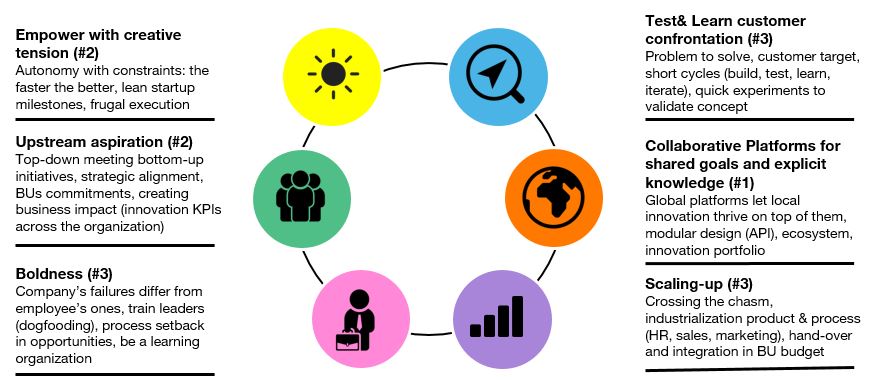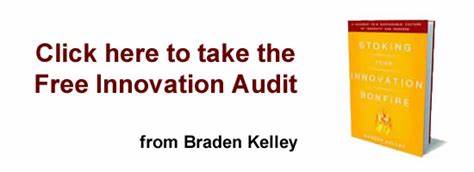Guest Post from Nicolas Bry
Innovation organization doesn’t thrive without innovation culture: organization and process without culture are like a factory without raw materials; culture without organization and process is appropriate to initiate a handful of innovation projects, but doesn’t scale.
Looking at 3 major innovation programs I shaped (open innovation with internet user and entrepreneurs, empowering employees with intrapreneurship, exploring and experimenting in short cycles in Africa), this correlation between organization and culture became obvious to me. Some fundamental pieces to assemble have come to my mind, in order to make innovation organization match with culture in a complete jigsaw: these essentials let fledgling innovators fly the nest, and seasoned ones hit the nail even better. Thus entrepreneurship can emerge as a second nature, and a core value for organizations.
1. Innovation Organization
To set-up a streamlined innovation process, I find these 3 organization pieces to be paramount:
1. Test and learn iterative path
Share the virus of test and learn in short cycles with your innovators; confronting the value proposition with the customer target as soon as possible to capture insights, and iterating positively on your solution as on your target users; avoiding the product bias pitfall: ‘don’t fall in love with your product, fall in love with the user problem’ as Ash Maurya says; spending the initial time on materializing the value proposition, designing mock-up to let users clearly visualize it and express feedback and insights; sorting out the key hypothesis to validate and the appropriate tests to perform, and capturing The Right It, without yet engaging in significant product development;
2. Collaborative platforms design
Open innovation blossoms with shared goals and explicit knowledge; to facilitate knowledge sharing, entice innovators to create a platform that let others create value on top of it, applying modular design from the very beginning; having in mind end-users and developers ecosystem as 2 different user targets; exposing building blocks (APIs) that can be quickly reused internally and externally to create instantly new businesses;
3. Scale-up preparation stage
Once product market fit is on the trend to prove true, the innovator’s venture shall anticipate the acceleration of sales and operations, the scale-up. Crossing the chasm and industrializing processes (marketing, product, sales, recruitment and on-boarding, partnerships) requires preparation, just as if you were upgrading your sailboat from a promenade near the coast to a transatlantic journey with heavy wind blowing. Have also in mind that the corporate scale-up has simultaneously to win.

2. Innovation Culture
To instill an innovation culture, I find these 3 cultural pieces quite efficient:
1. Empowerment with creative tension
Unleashing creativity and autonomy is fine, but a framework actually helps innovators; At Google, they say ‘innovation loves constraints’, and ‘the faster, the better’: speed is a constraint that pushes you to focus on the core, and to eliminate the superfluous, leading to frugal execution. ‘Less is more’ claimed famous designer Mies van der Rohe. In that sense, speed triggers a positive tension;
2. Upstream aspiration with C-level and business units commitment
Innovators often start bottom-up initiatives; at a certain point, innovators need to be aspired with C-level and business units support to leverage the corporation assets; explain to these sponsors how innovation differs from ideation, and that it seeks for business impact, just like marketing and sales: innovation is about conquering new customers, improving loyalty, differentiating from competition, creating value for the users and for the company; align innovators endeavors with corporation strategy, and gain credibility with quick wins in your innovation portfolio; you’ll know you have succeeded when business units will include innovation KPIs across the organization;
3. Stimulation of boldness, and risk taking spirit
innovation contests and crowdsourcing stimulate ideation if appropriate recognition comes along; if we want employees to further engage with boldness in execution, failure has to be accepted as part of the innovation process, as Gore company shows it with its Celebrate Failure event; do not underestimate that, while a company has dozen of successful projects to hide a failure behind the curtain, it’s not possible for an employee to offset an experience on his resume; how to detect opportunities out of setbacks, how to become a learning organization is a necessary culture: ‘I never fail, I either succeed or learn’ claimed Nelson Mandela. It requires training for the employees and for the leaders: letting the leaders embrace and learn from failure during a ‘eat your own dog food’ workshop is a fruitful practice I’m a great believer in.

Propagating a culture of organized innovation, while organizing innovation culture, you will durably shape people to become successful innovators, and win the game. That’s the best mean to achieve impactful outcome: innovation that change people’s lives.
Image credit: Pexels.com
![]() Sign up here to get Human-Centered Change & Innovation Weekly delivered to your inbox every week.
Sign up here to get Human-Centered Change & Innovation Weekly delivered to your inbox every week.


 One scary statistic is that 70% of change initiatives fail. An overwhelming proportion of new product launches fail. Most new businesses fail.
One scary statistic is that 70% of change initiatives fail. An overwhelming proportion of new product launches fail. Most new businesses fail.
